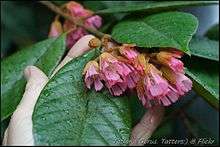Aceratium
Aceratium is a genus of about 20 species of trees and shrubs of eastern Malesia and Australasia from the family Elaeocarpaceae.[1][2][3][4][5] In Australia they are commonly known as carabeens.[4][5] They grow naturally in rainforests, as large shrubs to understorey trees and large trees.[1][2][4][5]
| Aceratium | |
|---|---|
 | |
| Aceratium ferrugineum flowering; cultivated plant at Roma Street Parkland, Brisbane, 11 Dec 2011, by Tatiana Gerus | |
-_flowering_tree.jpg) | |
| Scientific classification | |
| Kingdom: | Plantae |
| Clade: | Tracheophytes |
| Clade: | Angiosperms |
| Clade: | Eudicots |
| Clade: | Rosids |
| Order: | Oxalidales |
| Family: | Elaeocarpaceae |
| Genus: | Aceratium DC.[1][2] |
| Type species | |
| Aceratium oppositifolium DC. | |
| Species | |
|
See text | |
They grow naturally in New Guinea, the centre of diversity, in New Britain, New Ireland, Vanuatu, Sulawesi, Moluccas,[1] and in Australia, where botanists have formally described five species endemic to the Wet Tropics rainforests of northeastern Queensland.[2][4][5]
Some species have uses for their fruits as food and,[1] although not yet well known, some have popularity in cultivation, for example in Brisbane.
Selected species
- Aceratium archboldianum A.C.Sm. – New Guinea
- Aceratium braithwaitei (F.Muell.) Schltr. – New Guinea
- Aceratium brassii A.C.Sm. – New Guinea
- Aceratium concinnum (S.Moore) C.T.White – Qld, Australia
- Aceratium doggrellii C.T.White – Qld, Australia
- Aceratium ferrugineum C.T.White – Qld, Australia
- Aceratium ledermannii Schltr. – New Guinea, New Britain
- Aceratium megalospermum (F.Muell.) Balgooy – Qld, Australia
- Aceratium muellerianum Schltr. – New Guinea
- Aceratium oppositifolium DC. – Sulawesi, Moluccas, New Guinea region: Kai Islands through to the Santa Cruz group, New Britain, New Ireland, Solomon Islands
- Aceratium pachypetalum Schltr. – W New Guinea
- Aceratium parvifolium Schltr. – New Guinea
- Aceratium pittosporoides Schltr.; Syn: A. breviflorum Schltr. – New Guinea
- Aceratium sericeum A.C.Sm. – W New Guinea
- Aceratium sericoleopsis Balgooy – Qld, Australia
- Aceratium sinuatum Coode – New Guinea
- Aceratium sphaerocarpum Kaneh. & Hatus.; Syn: A. erythrocarpum A.C.Sm. – New Guinea
- Aceratium tomentosum Coode – New Guinea
_%E2%80%93_fruiting.jpg)
A. ferrugineum fruiting; cultivated plant at Roma Street Parkland, Brisbane, 11 Dec 2011, by Tatiana Gerus
gollark: You should now be able to (on supported mobile browsers) add osmarks.tk to your home screen!
gollark: Oh. Well, in that case no.
gollark: I don't even write C.
gollark: See, when you typically act erratically and do things for no apparent reason, it's hard to tell if you MEANT to do that.
gollark: I assumed you had hidden it for evil reasons.
References
- Coode, Mark J. E. (1995) [originally published 1981]. "Elaeocarpaceae". In Henty, E. E. (ed.). Handbooks of the Flora of Papua New Guinea. (Digitised, online, freely available via www.pngplants.org). Vol. 2 (reprinted ed.). Melbourne: Melbourne University Press. pp. 39–51. ISBN 0-522-84204-6. Retrieved 21 June 2013.
- "Aceratium%". Australian Plant Name Index (APNI), Integrated Botanical Information System (IBIS) database (listing by % wildcard matching of all taxa relevant to Australia). Centre for Plant Biodiversity Research, Australian Government. Retrieved 21 June 2013.
- Conn, Barry J. (2013) [2008+]. "Aceratium" (Online, from pngplants.org/PNGCensus). Census of Vascular Plants of Papua New Guinea. Retrieved 14 November 2013.
- Hyland, B. P. M.; Whiffin, T.; Zich, F. A.; et al. (December 2010). "Factsheet – Elaeocarpaceae". Australian Tropical Rainforest Plants (6.1, online version RFK 6.1 ed.). Cairns, Australia: Commonwealth Scientific and Industrial Research Organisation (CSIRO), through its Division of Plant Industry; the Centre for Australian National Biodiversity Research; the Australian Tropical Herbarium, James Cook University. Retrieved 21 June 2013.
- Cooper, Wendy; Cooper, William T. (June 2004). "Aceratium DC.". Fruits of the Australian Tropical Rainforest. Clifton Hill, Victoria, Australia: Nokomis Editions. p. 157. ISBN 9780958174213. Archived from the original on 9 April 2013. Retrieved 21 June 2013.
This article is issued from Wikipedia. The text is licensed under Creative Commons - Attribution - Sharealike. Additional terms may apply for the media files.